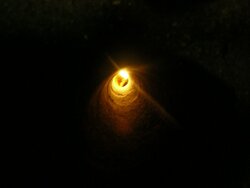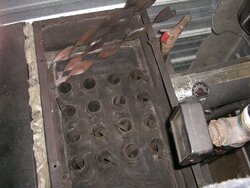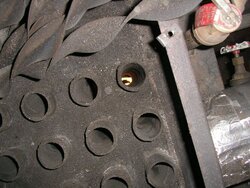Since the role of turbs. is to cause turbulation in the air flow, is it really necessary to brush them clean, or maybe just shake the loose ash off. They don't really transfer any heat like the tubes as far as I can see. In fact if they are a bit dirty they should casue more friction to the air moving through the tubes, slowing it down and giving a fraction of a second more for heat transfer... No? Am I missing something?
Is cleaning Turbulators really important?
- Thread starter ohbie1
- Start date
-
Active since 1995, Hearth.com is THE place on the internet for free information and advice about wood stoves, pellet stoves and other energy saving equipment.
We strive to provide opinions, articles, discussions and history related to Hearth Products and in a more general sense, energy issues.
We promote the EFFICIENT, RESPONSIBLE, CLEAN and SAFE use of all fuels, whether renewable or fossil.
You are using an out of date browser. It may not display this or other websites correctly.
You should upgrade or use an alternative browser.
You should upgrade or use an alternative browser.
- Status
- Not open for further replies.
hobbyheater
Minister of Fire
ohbie1 said:Since the role of turbs. is to cause turbulation in the air flow, is it really necessary to brush them clean, or maybe just shake the loose ash off. They don't really transfer any heat like the tubes as far as I can see. In fact if they are a bit dirty they should casue more friction to the air moving through the tubes, slowing it down and giving a fraction of a second more for heat transfer... No? Am I missing something?
I have found that if you clean the tabulators, it drops the stack temperature. Keep track of the stack temperature before and after you clean them and then you will know for sure .
woodsmaster
Minister of Fire
hobbyheater
Minister of Fire
Just for interest I'm going to leave one turbulator dirty for a year and see if the soot pattern in the fire tube is any different than the others .
Frost on an aircraft wing will destroy the air flow and lift. I'm thinking dirty turbulators lose their ability to make turbulence, allowing the hot gasses a straighter pathway through the fire tube.
Have attached a picture of a fire tube and the soot pattern in a fire tube that has its tubulator cleaned each time the tubes are cleaned.
Frost on an aircraft wing will destroy the air flow and lift. I'm thinking dirty turbulators lose their ability to make turbulence, allowing the hot gasses a straighter pathway through the fire tube.
Have attached a picture of a fire tube and the soot pattern in a fire tube that has its tubulator cleaned each time the tubes are cleaned.
Attachments
I have found that if you clean the tabulators, it drops the stack temperature. Keep track of the stack temperature before and after you clean them and then you will know for sure .
Cleaning the tubes definitely lowers the stack temp, but suppose you cleaned the tubes and just shook the loose stuff off the turbs. The experiment will call for cleaning the tubes but not turbs. and then another time cleaning the tubes AND the turbs. With all the variables (wood type,moisture of the load,how stacked in the boiler, draft, wind outside etc. etc.), I think several tests like this will be needed to identify a pattern. Hopefully there's very little diff.; that wold save the work of brushing the turbs. at each cleaning.
flyingcow
Minister of Fire
I do it because i got them out anyways. But i also have a quick and easy way to clean them. Pressure washer. it was a PITA to do by brush. I was seriously considering replacing them with chains, until i started using the washer.
in hot water
New Member
I think when a boiler manufacturer designs a boiler the tubes are sized to carry the energy the fire can produce. Adding tuburlators does limit the amount of energy flow thru those tubes. I suspect the addition of turbulance the tuburlators induce offsets the loss of space they take up. So there is always a trade off. I would keep the turbulators clean to allow as much airflow as possible. Limiting the flow thru the tubes, by allowing deposits to collect on the tubulators reduces the flow and also the available ID of the tube for efficient heat transfer.
Turbulators are common in commercial fired boilers but fossil fuels tend to burn much cleaner. Other than the mess involved I see no downside to keeping the fire tubes and turbs clean.
hr
Turbulators are common in commercial fired boilers but fossil fuels tend to burn much cleaner. Other than the mess involved I see no downside to keeping the fire tubes and turbs clean.
hr
willworkforwood
Feeling the Heat
FWIW, Econoburn (and I think EKO) includes a shaker assembly, which moves the turbulators up and down inside the tubes, driven by an external handle on the side of the boiler. I clean the tubes every 3-4 weeks, and the turbs are consistently free of any significant deposits. So, perhaps if the turbs in your Tarm can't be shaken down, then maybe a larger build up is possible, and may affect performance. But that's pure speculation, and may not be the case at all.
salecker
Minister of Fire
Hi Willworkforwood
When you clean your tubes...how much buildup do you have on them?
I checked mine last week and they seemed to have a light coating of ash which falls off when scraped.
Thanks Thomas
When you clean your tubes...how much buildup do you have on them?
I checked mine last week and they seemed to have a light coating of ash which falls off when scraped.
Thanks Thomas
willworkforwood
Feeling the Heat
I call the stuff in my boiler tubes "impacted ash" because it doesn't just drop off when brushed by hand. It's not a thick layer, and also not anything serious like creosote, however it does take a bit of a push to kick it off the walls. But this year I changed over to spinning the brush on 3/8" threaded rod, and now the drill does all the work ;-). Takes about a minute per tube to get them back down to the metal. Running your boiler with storage as you do, it would make sense that your tube deposits are lighter than mine - much more like loose fly ash, as you said.salecker said:Hi Willworkforwood
When you clean your tubes...how much buildup do you have on them?
I checked mine last week and they seemed to have a light coating of ash which falls off when scraped.
Thanks Thomas
EffectaBoilerUser (USA)
Member
My effecta lambda 35 boiler control panel keeps track of the total hours of operation in addition to the hours since last cleaning.
Being on my second winter with this boiler, I have determined that at about 200-250 hours my smoke(chimney) temp increases by approx. 30-40C. Thus, every 200-250 hours of boiler operation I remove my turbulators and shake them off. I also run the factory supplied heat exchanger brush up and down each tube 3-4 times. This whole process takes approx. 10 minutes and is done with the rear mounted fan on, so as to suck up the air borne dust created when cleaning the tubes.
At 5 hours per burn, that means that I am cleaning the tubes and shaking off the turbulators every month to month and a half.
Hope this helps.
Brian
Being on my second winter with this boiler, I have determined that at about 200-250 hours my smoke(chimney) temp increases by approx. 30-40C. Thus, every 200-250 hours of boiler operation I remove my turbulators and shake them off. I also run the factory supplied heat exchanger brush up and down each tube 3-4 times. This whole process takes approx. 10 minutes and is done with the rear mounted fan on, so as to suck up the air borne dust created when cleaning the tubes.
At 5 hours per burn, that means that I am cleaning the tubes and shaking off the turbulators every month to month and a half.
Hope this helps.
Brian
jebatty
Minister of Fire
Yesterday checked the turbulators and fire tubes on the Froling FHGL-50, been burning since the start of the 2011-12 heating season. Nothing on the turbs or tubes of any consequence. The Froling has an easy to use simple lever that moves the spring-like turbs up and down the fire tubes, cleaning the tubes and the turbs in a couple of quick movements.
On the Tarm Solo 40 Plus I remove my homemade chain turbs every 2-4 weeks and just shake them off, and then I also brush the fire tubes. There is some buildup of flyash on the tubes and practically nothing on the turbs. About a 15 minute job for 8 turbs/tubes.
On the Tarm Solo 40 Plus I remove my homemade chain turbs every 2-4 weeks and just shake them off, and then I also brush the fire tubes. There is some buildup of flyash on the tubes and practically nothing on the turbs. About a 15 minute job for 8 turbs/tubes.
I have 440 hours of operation on my Froling, since Oct 1st, with 3 hours of slumber.
a)did an interior HX tube cleaning with supplied brush at 150 hours just for practice, nothing by light fly ash.
b)did another interior HX tube cleaning at 250 hrs, same fly ash build up, a few rotational passes(about 10) of the supplied brush and metal was visible.
Next burn a decrease of 30C(from 220C to 190C -- 428F down to 374F ) in max Flue Gas temps was observed(avg burn FG temp 170C-185C(338-365F).
c) Currently at 440 hours, max FG temps observed is 205C(400.2F),(avg burn FG temp 175C-195C(348-382F)
Debating another brushing pending on rise of FG temps. If same, will wait until end of heating season to do service on entire boiler,
including flue pipe inspection(not easy with silicone sealed double wall pipe!!)
Will attempt to run fiberoptic cable cam(if I can borrow one) through top side HX opening and up into flue pipe for visual inspection and if cleaning is needed, I will remove the fan and run a brush up through that opening...1st attempt..we we'll see..anything other that having to remove that pipe!! if anyone has any ideas or experience regarding this, please share with me, as this has been an ever widening learning curve.
Btw, chimney liner(clay7x7, have no stainless)looks to have light coating of fly ash as well, no creosote whatsoever in chimney, HX tubes or anywhere else. No condensation observed inside liner, just on exterior crown, caused by large bluestone chimney cap.
Scott
a)did an interior HX tube cleaning with supplied brush at 150 hours just for practice, nothing by light fly ash.
b)did another interior HX tube cleaning at 250 hrs, same fly ash build up, a few rotational passes(about 10) of the supplied brush and metal was visible.
Next burn a decrease of 30C(from 220C to 190C -- 428F down to 374F ) in max Flue Gas temps was observed(avg burn FG temp 170C-185C(338-365F).
c) Currently at 440 hours, max FG temps observed is 205C(400.2F),(avg burn FG temp 175C-195C(348-382F)
Debating another brushing pending on rise of FG temps. If same, will wait until end of heating season to do service on entire boiler,
including flue pipe inspection(not easy with silicone sealed double wall pipe!!)
Will attempt to run fiberoptic cable cam(if I can borrow one) through top side HX opening and up into flue pipe for visual inspection and if cleaning is needed, I will remove the fan and run a brush up through that opening...1st attempt..we we'll see..anything other that having to remove that pipe!! if anyone has any ideas or experience regarding this, please share with me, as this has been an ever widening learning curve.
Btw, chimney liner(clay7x7, have no stainless)looks to have light coating of fly ash as well, no creosote whatsoever in chimney, HX tubes or anywhere else. No condensation observed inside liner, just on exterior crown, caused by large bluestone chimney cap.
Scott
- Status
- Not open for further replies.
Similar threads
- Replies
- 12
- Views
- 1K
- Replies
- 27
- Views
- 2K
- Replies
- 1
- Views
- 855




